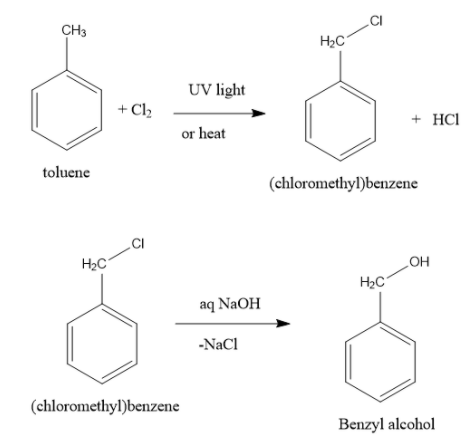
How will you prepare benzyl alcohol from toluene?
Answer
501.3k+ views
Hint: Toluene contains a methyl group attached to a phenyl group. Benzyl alcohol contains a hydroxymethyl group attached to a phenyl group. First replace one hydrogen atom of methyl group of toluene with a chlorine atom. Then replace the chlorine atom with a hydroxyl group.
Complete answer:
In toluene, a methyl group is attached to a benzene ring. In benzyl alcohol, one hydroxyl group is attached to the benzyl group. A benzyl group is a combination of methylene group with phenyl group.
The conversion of toluene into benzyl alcohol can be achieved in two steps.
Free radical chlorination of toluene with chlorine in presence of ultraviolet light or heat give benzyl chloride. One hydrogen atom of methyl group of toluene is replaced with chlorine atom. A molecule of hydrogen chloride is eliminated. In this reaction, the benzene ring remains as it is. No reaction occurs between benzene ring and chlorine. Only the aliphatic methyl group reacts with chlorine.
In the next step, benzyl chloride undergoes nucleophilic substitution reaction in presence of aqueous sodium hydroxide solution to form benzyl alcohol. A molecule of sodium chloride is eliminated.

Note: Alkyl halides react with aqueous sodium hydroxide to undergo substitution reaction, in which halogen atom is replaced with hydroxyl group. If instead of aqueous sodium chloride, the reagent used is alcoholic sodium hydroxide, then alkyl halides prefer dehydrohalogenation reaction.
Complete answer:
In toluene, a methyl group is attached to a benzene ring. In benzyl alcohol, one hydroxyl group is attached to the benzyl group. A benzyl group is a combination of methylene group with phenyl group.
The conversion of toluene into benzyl alcohol can be achieved in two steps.
Free radical chlorination of toluene with chlorine in presence of ultraviolet light or heat give benzyl chloride. One hydrogen atom of methyl group of toluene is replaced with chlorine atom. A molecule of hydrogen chloride is eliminated. In this reaction, the benzene ring remains as it is. No reaction occurs between benzene ring and chlorine. Only the aliphatic methyl group reacts with chlorine.
In the next step, benzyl chloride undergoes nucleophilic substitution reaction in presence of aqueous sodium hydroxide solution to form benzyl alcohol. A molecule of sodium chloride is eliminated.

Note: Alkyl halides react with aqueous sodium hydroxide to undergo substitution reaction, in which halogen atom is replaced with hydroxyl group. If instead of aqueous sodium chloride, the reagent used is alcoholic sodium hydroxide, then alkyl halides prefer dehydrohalogenation reaction.
Recently Updated Pages
Master Class 11 English: Engaging Questions & Answers for Success

Master Class 11 Computer Science: Engaging Questions & Answers for Success

Master Class 11 Maths: Engaging Questions & Answers for Success

Master Class 11 Social Science: Engaging Questions & Answers for Success

Master Class 11 Physics: Engaging Questions & Answers for Success

Master Class 11 Chemistry: Engaging Questions & Answers for Success

Trending doubts
Give 10 examples of unisexual and bisexual flowers

Draw a labelled sketch of the human eye class 12 physics CBSE

Differentiate between homogeneous and heterogeneous class 12 chemistry CBSE

Differentiate between insitu conservation and exsitu class 12 biology CBSE

What are the major means of transport Explain each class 12 social science CBSE

What is the difference between resemblance and sem class 12 social science CBSE




